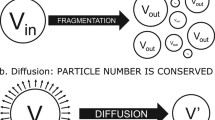Abstract
A theoretical analysis on the controlled release of an active reagent from an inwardly tapered polymeric disk with a central releasing hole proposed originally by Bechard and McMullen (J Pharm Sci 77:222–228, 1988) is conducted. Analytic expressions for the temporal variations in the amount of reagent released and the size of the unreleased portion of the device are derived. Relaxing their assumptions of pseudo-steady and constant reagent concentration in the hole, the problem is reanalyzed. The resultant model is suitable to the whole release period, and successfully describes their experimental data. To make the analytic result derived more readily applicable, the results for some special cases are also presented.




Similar content being viewed by others
References
Roseman TJ (1972) Release of steroids from a silicone polymer. J Pharm Sci 61:46–50
Brooke D, Washkuhn RJ (1977) Zero-order drug delivery system: theory and preliminary testing. J Pharm Sci 66:159–162
Lipper RA, Higuchi WI (1977) Analysis of theoretical behavior of a proposed zero-order drug delivery system. J Pharm Sci 66:163–164
Hsieh DST, Rhine WD, Langer R (1983) Zero-order controlled-release polymer matrices for micro- and macromolecules. J Pharm Sci 72:17–22
Hansson AG, Giardino A, Cardinal JR, Curatolo W (1988) Perforated coated tablets for controlled release of drugs at a constant rate. J Pharm Sci 77:322–324
Rhine WD, Sukhatme V, Hsieh DST, Langer RS (1980) A new approach to achieve zero-order release kinetics from diffusion-controlled polymer matrix system. In: Baker R (ed) Controlled release of bioactive materials. Academic Press, New York, pp 177–187
Lin SH, Hsu JP, Tseng S (2005) Modeling the controlled release of medication embedded in a plate-like polymer matrix. Chem Eng Sci 60:1295–1301
Liu BT, Hsu JP (2006) Theoretical analysis on diffusional release from ellipsoidal drug delivery devices. Chem Eng Sci 61:1748–1752
Liu BT, Hsu JP (2005) Inward release polymer matrix covered by a permeable membrane: a possible zero-order controlled release device. Chem Eng Sci 60:5803–5808
Maderuelo C, Zarzuelo A, Lano JM (2011) Optimization of release kinetics from sustained-release formulations using model-independent pharmacokinetic simulation. J Pharm Sci 100:3260–3267
Li X, Li L, Wang X, Ren Y, Zhou T, Lu W (2012) Application of model-based methods to characterize exenatide-loaded double-walled microspheres: in vivo release, pharmacokinetic/pharmacodynamic model, and in vitro and in vivo correlation. J Pharm Sci 101:3946–3961
Xu Y, Jia Y, Wang Z, Wang Z (2013) Mathematical modeling and finite element simulation of slow release of drugs using hydrogels as carriers with various drug concentration distributions. J Pharm Sci 102:1532–1543
Bechard S, McMullen JN (1988) Solute release from a porous polymeric matrix: inwardly tapered disk with a central releasing hole. J Pharm Sci 77:222–228
Hsu JP, Liu BT (1994) Unsteady state, nonisothermal dissolution of a solid particles in liquid. J Chem Soc Faraday Trans 90:1435–1439
Acknowledgments
This work is sponsored by the Ministry of Science and Technology, Republic of China.
Author information
Authors and Affiliations
Corresponding author
Appendix
Appendix
Suppose that the solution to (5) takes the following form:
The boundary conditions (5a) and (5b), suggest that X(x) has the form \(\sin [{n}\pi {x/}({R}-{A})]\), \(n=1,2,{\ldots }\) Therefore, by applying the principle of superposition,
Substituting this expression into (5) yields
where \(S(x,t)=-[(R-x-A)A(\mathrm{d}C_\mathrm{b}/\mathrm{d}t)]/(R-A)\). Expand S(x, t) as
That is, \(S_{n}(t)\) is the coefficient of the Fourier sine series of S(x,t) on the interval \([0,R-A\)]. It can be shown that

Substituting (26) in (25) yields
Equations (24) and (5c) suggest that
It can be shown that
Solving (28) subject to (30) and noting that \(S_{n}(0)=0\), (8a) in the text can be recovered.
Rights and permissions
About this article
Cite this article
Tseng, S., Su, RR., Hsu, JP. et al. Modeling the release of a reagent from an inwardly tapered disk with a central hole. J Eng Math 98, 1–9 (2016). https://doi.org/10.1007/s10665-015-9806-x
Received:
Accepted:
Published:
Issue Date:
DOI: https://doi.org/10.1007/s10665-015-9806-x




